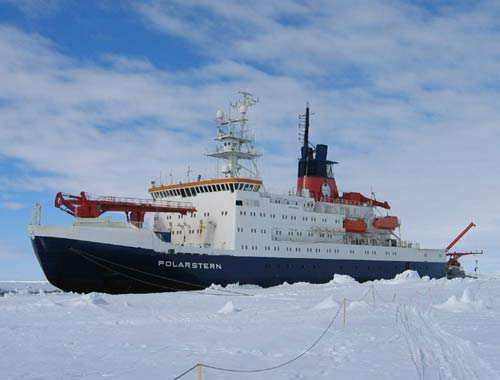Polarstern icebreaker explores the seafloor not yet on the map
The huge seabed areas (about 3,250 km²) were cleared by the collapse of 4 years ago of the Larsen B shelf along the Antarctic Peninsula - leaving a void on the Antarctic maps. Polarstern, the research command ship of Alfred Wegener Institute of Polar and Marine Research, will soon proceed at that first important biology study, studying populations from bacteria to whales. including fish and squid on the seabed.
Some of the other 25 research projects will be undertaken by 47 scientists, including diverse industries such as undersea organisms, plankton, organisms, ecology, physiology and geology. biochemistry, genetics, sea depth measurements, etc.
The first part of the expedition will focus on biology studies of fish populations as a contribution to the Antarctic Conservation of Marine Animal Sources (CCAMLR, http:///www.ccamlr.org) , followed by 12 similar surveys since 1976. Researchers will monitor the former fishing grounds located on the western Antarctic Peninsula to determine the recovery status. clothes of the population.

Polarstern is a double-layer icebreaker that operates at temperatures as low as 50 ° C.
(Acknowledged by: Alfred Wegener Maritime and Polar Research Institute) - Photo: esr.org
When the Antarctic ice sheets reach the coast of the continent, they begin to drift and become ice shelves, thereby breaking into icebergs. Since 1974, a total of 13,500 square kilometers of ice shelves have broken out on the Antarctic Peninsula, a phenomenon associated with the region's temperature rising to more than 2 ° C in the past 50 years. The growing number of scientists is concerned that similar ice breaks in other regions may lead to an increase in ice flow and sudden sea level rise. The last collapse of Larsen B shelf in February 2002 was the most recent and biggest of these catastrophic events related to global warming but not very sure, releasing an additional 3,250 km 2 Seabed with a covered ice layer that is estimated to exist there for at least 5,000 years.
Meanwhile, the iceberg disappeared that allowed plankton including plants and animals to invade and grow in these areas, creating an ideal opportunity to study the evolution of the lower animal populations. Seabed based on plankton. Making a prototype with various trawls, baskets, and traps and the use of a remote control with a video camera will allow the description of new species in an almost primitive environment. More than ten scientific studies will investigate other groups such as bacteria, sponges, crustaceans, octopus, starfish, and whales from land boundaries to offshore areas and more will offer Best benchmark for the early colonial stages. These studies could become references to other areas in Antarctica where the disintegration of such ice shelves has been envisaged on how the movements in gas diversity Post-triggering will change in structural ecosystems primarily from ice.
The expedition will also lead to the first biological studies of a cold-air ecosystem in the same Larsen area, the first known in Antarctica . Discovered in 2005 by an American geological science team, this 8-kilometer area contains rock mounds that emit fluid and mud particles, as well as large clams. These mollusks and related fauna probably depend on the chemical energy from the Earth rather than the energy supplied by photosynthesis from the sun or from the hot gas emitted from inside the planet.
With 47 scientists on board with more than 12 different nationalities, Polarstern's expedition together brings together an international network of research programs that will focus on the biological characteristics of this gap. , from November 2006 to January 2007. One of the main contributors to the ' population ' survey of Antarctic marine life (CAML for short), the voyage of Polarstern will be an important event in IPY (International Polar Year), and paved the way for more extreme expeditions.
Thien Kim
- Russia deployed a nuclear icebreaker to the Arctic, looking like it came out of Star Wars
- The largest polar expedition in history
- Russian ships break ice to fuel Alaska
- South Korea seeks fire in the Arctic
- Video: The world's most powerful ice-breaking atomic ship
- Scientists shocked because NASA stopped producing the only ship to explore the moon
- Canada launched a new mission in the North Pole
- Marine environmental simulation equipment
- Diving robots 'self-planning experiments'
- 'Underwater plane' explores the ocean floor
- Detecting UFOs on the seabed
- Robot explores the depths of the sea beyond the Earth
 'Fine laughs' - Scary and painful torture in ancient times
'Fine laughs' - Scary and painful torture in ancient times The sequence of numbers 142857 of the Egyptian pyramids is known as the strangest number in the world - Why?
The sequence of numbers 142857 of the Egyptian pyramids is known as the strangest number in the world - Why? History of the iron
History of the iron What is alum?
What is alum?